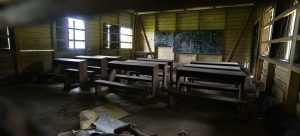Twila Cassadore hopes teaching Western Apache traditional foodways can aid mental, emotional and spiritual health
On a warm day in April, Twila Cassadore piloted her pickup truck toward the mountains on the San Carlos Apache Reservation in Arizona to scout for wild edible plants. A wet winter and spring rains had transformed the desert into a sea of color: green creosote bushes topped with small yellow flowers, white mariposa lilies, purple lupines and poppies in full bloom.
Cassadore and I drove up a rough dirt road that used to be an old cattle trail, passing through various ecosystems, moving from Sonoran desert to grasslands and piñon-juniper woodlands. In each area, Cassadore would stop to gather desert chia seeds, cacti flowers and thistles.
Cassadore stopped her truck beside a three-leafed sumac bush brimming with fruit. “If you suck on them, they taste like sour lemonade,” she said, removing the fuzzy, white unripened berries from the bush. Cassadore will make a slushy when they are ripe by blending the berries with wood sorrel and ice. “Better for you than Kool-Aid,” she said.

As a forager and celebrated food educator, Cassadore, 56, has spent the past 30 years documenting and teaching her fellow Western Apache people about the importance of wild foods in a region that’s considered one of the most biodiverse in the US – yet where diet and substance abuse are leading causes of death. Working closely with the tribe’s wellness center, the local high school and recovery groups, she often takes people out into the land to forage, cook and heal.
Foraged food accounted for up to 50% of the Western Apache diet in pre-reservation times. In spring, it’s onions, potatoes, miner’s lettuce and thistles. In summer, it’s cacti fruit, berries and acorns – “the most prized food in our community”, Cassadore said. But after being forced on to reservations, the Apache were forbidden to gather their traditional foods and became dependent on rations and later, commodities. By the time Cassadore was growing up on the 1.8m-acre reservation, she said that many people looked down on foraged food, or associated it with poverty.
So she was often teased by her elementary school classmates for bringing homemade beef jerky, acorns, pine nuts and dried mesquite pods foraged by her and her family, instead of the candy bars and sodas that everyone else had. Today the White River, San Carlos and Fort Apache reservations are considered food deserts with few grocery stores and limited access to fresh, healthy foods.

“When you go to school with foraged food, you almost got bullied,” she said. “That was traumatizing for me, and I was embarrassed to bring food from my own home. To me, eating foraged food, this was normal. I didn’t know Lucky Charms existed.”
Cassadore later struggled with drug addiction and mental health issues for much of her life, but said that foraging provided her a way out. It allowed her to reconnect to her “identity, culture and people”, she said. She spent years learning about traditional foodways, gaining the trust of community elders, listening to their stories, and harvesting the foods of her ancestors.
This gave her purpose and “filled this void I had felt most of my life”, said Cassadore, who is now more than 20 years sober. “Foraging healed me.”
Through her work, Cassadore now helps others struggling with addiction, depression and other mental health issues. “They come back with a connection of who they are, as an Apache person,” said Cassadore, recalling leading a traditional gloscho (desert woodrat) hunt with patients from a drug and alcohol rehabilitation center. “It wakes up something inside of people. It calms them and makes them want to get better.”
Naelyn Pike spent the summer after graduating high school working with Cassadore through the Traditional Western Apache Diet Project, a program to document and study traditional Ndee/Nnee (Western Apache) knowledge of the natural world and highlight the benefits of pre-reservation life and foods. Pike and other Apache youth spent days in the field with Cassadore, the organization’s project assistant, learning about Apache foods, recipes and traditions.
“It left a huge mark on my life,” said 23-year-old Pike, an Indigenous rights activist and executive assistant to the office of the chairman for the San Carlos Apache Tribe. “It teaches us the importance of our way of life as Apache people.”
Like many of her peers, Pike has re-embraced foraging since her time with Cassadore, spending time each summer harvesting acorns, saguaro fruit and other wild foods.

“I am very confident that when we go back to Apache foods, it doesn’t just benefit us physically, but mentally, emotionally and spiritually,” she said. “Taking part in this project has opened my eyes to understanding traditional values and how important our food is. We want to reclaim, preserve and grasp on to this way of life.”
Tribal officials told the Guardian that people on the San Carlos Apache Reservation are facing interconnected epidemics of substance abuse, suicide and sexual violence – and the threat of ecological collapse. “For traditional people, these are all completely related,” said one tribal official who asked not to be named. “There are all kinds of historical reasons for people not living a balanced way of life. People like Twila are working really hard to bring the community back into this balance.”
Cassadore favors particular plants at specific locations and elevations. “I can’t remember where a restaurant is, but I can remember exactly where a plant is,” she said. Her favorite patch of prickly pear is at the base of a cliff band below a series of Anasazi cave ruins. Cassadore will make fruit leather and a vibrant purple-colored prickly pear sugar – “messy but delicious”.
Cassadore is often scouting for the future. The banana yucca fruit won’t be ripe until October. However, the development of the flowers in spring will determine the plant’s fruit production.
“A big patch like this is the best place to harvest,” she said of a large concentration of blooming banana yuccas whose white flowers resemble squash blossoms. When roasted, the fruit is “apple-sauce sweet”. She plans to return here in the fall to teach people from the community how to gather and prepare the fruit.

Along with foraging, Cassadore has interviewed more than 100 elders to help identify more than 200 wild edible plants and hundreds of traditional recipes, like acorn soup and agave pie with crust made from foraged seeds.
She pulled her black Toyota truck off the side of Route 70 toward a patch of volcanic soil blanketed in small white flowers. She grabbed a screwdriver from the center console and started to dig wild vegetables from the rocky ground. “Onions,” she said. “Collect and be grateful. Only take what you need.” She plans to eat them with dinner, along with elk and wild roasted potatoes foraged weeks earlier.
“If you really want to start healing, work with the earth and ingredients that were given to us,” she said.




